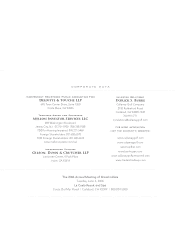Callaway 2005 Annual Report Download - page 17
Download and view the complete annual report
Please find page 17 of the 2005 Callaway annual report below. You can navigate through the pages in the report by either clicking on the pages listed below, or by using the keyword search tool below to find specific information within the annual report.PART I
Item 1. Business
Callaway Golf Company (the “Company” or “Callaway Golf”) was incorporated in California in 1982 and
reincorporated in Delaware on July 1, 1999. In 1997, the Company acquired substantially all of the assets of
Odyssey Sports, Inc., which manufactured and marketed the Odyssey brand of putters and wedges. In 1998, the
Company began a reorganization of its international operations by acquiring the distribution rights in certain key
international markets. As a result, during 1998 through 2001, the Company acquired distribution rights and
substantially all of the assets from its distributors in Japan, France, Belgium, Norway, Denmark, Germany,
Japan, Ireland, Spain, Canada, Korea and Australia. In 2000, the Company entered the golf ball business with the
release of its first golf ball product. In 2003, the Company acquired through a court-approved sale substantially
all of the golf-related assets of the TFGC Estate Inc. (f/k/a The Top-Flite Golf Company, f/k/a Spalding Sports
Worldwide, Inc.), which included golf ball manufacturing facilities, the Top-Flite and Ben Hogan brands, and all
golf-related patents and trademarks (the “Top-Flite Acquisition”). Beginning in 2001, the Company and its
participating retailers partnered with FrogTrader, Inc. to develop the Trade In! Trade Up! program. In 2004, the
Company acquired all of the issued and outstanding shares of stock of FrogTrader (which subsequently changed
its name to Callaway Golf Interactive, Inc.). The Company acquired FrogTrader to stimulate purchases of new
clubs by growing its Trade In! Trade Up! program and to enable the Company to better manage the distribution
of pre-owned golf clubs and the Callaway Golf brand. The Company currently has the following wholly-owned
operating subsidiaries: Callaway Golf Sales Company, The Top-Flite Golf Company, Callaway Golf Interactive,
Inc., Callaway Golf Europe Ltd., Callaway Golf K.K., Callaway Golf Korea Ltd., Callaway Golf Canada Ltd.
and Callaway Golf South Pacific PTY Ltd.
The Company, together with its subsidiaries, designs, manufactures and sells high quality golf clubs
(drivers, fairway woods, hybrids, irons, wedges and putters) and golf balls. The Company also sells golf
accessories such as footwear, golf bags, golf gloves, golf headwear, golf towels and golf umbrellas. The
Company generally sells its products to golf retailers (including pro shops at golf courses as well as off-course
retailers), sporting goods retailers and mass merchants, directly and through its wholly-owned subsidiaries, and
to third party distributors. The Company also sells pre-owned golf products through its website,
www.callawaygolfpreowned.com. The Company’s products are sold in the United States and in over 100
countries around the world. The Company’s products are designed for the enjoyment of both amateur and
professional golfers. Golfers generally purchase the Company’s products on the basis of performance, ease of use
and appearance. In addition, the Company licenses its trademarks and service marks in exchange for a royalty fee
to third parties for use on products such as golf apparel, footwear, watches, travel gear and eyewear. The
Company’s business is seasonal and as a result approximately two-thirds of its sales occur during the first half of
its fiscal year (see below “Certain Factors Affecting Callaway Golf Company—Seasonality and Adverse
Weather Conditions” contained in Item 1A).
Financial Information about Segments and Geographic Areas
Information regarding the Company’s segments and geographic areas in which the Company operates is
contained in Note 14 to the Company’s Consolidated Financial Statements for the years ended December 31,
2005, 2004 and 2003 (“Consolidated Financial Statements”), which note is incorporated herein by this reference
and is included as part of Item 8. “Financial Statements and Supplementary Data.”
Products
The Company designs, manufactures and sells high quality golf clubs and golf balls and also sells golf
footwear and accessories. The Company designs its products to be technologically-advanced and in this regard
invests a considerable amount in research and development each year. The Company’s products are designed for
golfers of all skill levels, both amateur and professional.
1
























